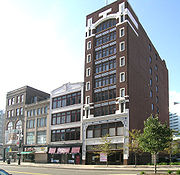.gif)
Broadway Avenue Historic District (Detroit, Michigan)
Encyclopedia
The Broadway Avenue Historic District is a historic district located on a single city block along Broadway Avenue between Gratiot and East Grand River in Downtown Detroit, Michigan
. It was listed on the National Register of Historic Places
in 2004. The Broadway Avenenue Historic District joins the Randolph Street Commercial Buildings Historic District
, a rare surviving commercial area which dates from the 1840s.
 The Broadway Avenue Historic District is located along a single block of Broadway Avenue, and contains eleven commercial buildings built between 1896 and 1926. Three of those buildings—the Cary Building
The Broadway Avenue Historic District is located along a single block of Broadway Avenue, and contains eleven commercial buildings built between 1896 and 1926. Three of those buildings—the Cary Building
and the Breitmeyer-Tobin Building at the southern end, and the Merchants Building
at the north end—are listed on the National Register of Historic Places
in their own right.
The architectural terra cotta
used on these structures unifies the appearance of the district. The district is significant for its architecture, its commercial history, its ethnic heritage, and for its association with Philip Breitmeyer
, mayor of Detroit from 1909-1911.
 The area where the district is located was developed in the late 1800s as a commercial area catering to the women's trade, and included businesses such as hairdressers, florists, corset makers, and fashionable clothiers. A number of these women's trade shops were owned by ethnic immigrants. During the 1910s, the area began transforming into a banking and financial center. In the adjoining Randolph Street Commercial Buildings Historic District
The area where the district is located was developed in the late 1800s as a commercial area catering to the women's trade, and included businesses such as hairdressers, florists, corset makers, and fashionable clothiers. A number of these women's trade shops were owned by ethnic immigrants. During the 1910s, the area began transforming into a banking and financial center. In the adjoining Randolph Street Commercial Buildings Historic District
, the building at 1244 Randolph St. is a rare survivor from the 1840s. The Breitmeyer-Tobin Building, now called the Harmonie Centre on Broadway Avenue, opened to African-American tenants in 1936. In the 1950s, ethic and immigrant-owned shops moved into the area, with some of them still in the districts to the present day .The east necklace of downtown links Grand Circus and the stadium area to Greektown along Broadway. The east neckace contains a sub-district sometimes called the Harmonie Park District in the Broadway Avenue Historic District which has taken on the renowned legacy of Detroit's music from the 1930s through the 1950s and into the present.
Michigan
Michigan is a U.S. state located in the Great Lakes Region of the United States of America. The name Michigan is the French form of the Ojibwa word mishigamaa, meaning "large water" or "large lake"....
. It was listed on the National Register of Historic Places
National Register of Historic Places
The National Register of Historic Places is the United States government's official list of districts, sites, buildings, structures, and objects deemed worthy of preservation...
in 2004. The Broadway Avenenue Historic District joins the Randolph Street Commercial Buildings Historic District
Randolph Street Commercial Buildings Historic District
The Randolph Street Commercial Buildings Historic District is a historic district located in Detroit, Michigan, which includes six buildings along Randolph Street between Monroe and Macomb streets . The district was listed on the National Register of Historic Places in 1980...
, a rare surviving commercial area which dates from the 1840s.
Description and significance

Cary Building (Detroit, Michigan)
The Cary Building is a commercial building located at 229 Gratiot Avenue in Detroit, Michigan. It was listed on the National Register of Historic Places in 1983.- History :...
and the Breitmeyer-Tobin Building at the southern end, and the Merchants Building
Merchants Building
The Merchants Building is a commercial building located at 206 E. Grand River Avenue in Detroit, Michigan. It is also known as the Broadway Merchants Building. It was listed on the National Register of Historic Places in 1983....
at the north end—are listed on the National Register of Historic Places
National Register of Historic Places
The National Register of Historic Places is the United States government's official list of districts, sites, buildings, structures, and objects deemed worthy of preservation...
in their own right.
The architectural terra cotta
Terra cotta
Terracotta, Terra cotta or Terra-cotta is a clay-based unglazed ceramic, although the term can also be applied to glazed ceramics where the fired body is porous and red in color...
used on these structures unifies the appearance of the district. The district is significant for its architecture, its commercial history, its ethnic heritage, and for its association with Philip Breitmeyer
Philip Breitmeyer
Philip Breitmeyer was a florist, one of the founders of Florists' Telegraph Delivery , and the mayor of Detroit, Michigan.-Biography:...
, mayor of Detroit from 1909-1911.
History

Randolph Street Commercial Buildings Historic District
The Randolph Street Commercial Buildings Historic District is a historic district located in Detroit, Michigan, which includes six buildings along Randolph Street between Monroe and Macomb streets . The district was listed on the National Register of Historic Places in 1980...
, the building at 1244 Randolph St. is a rare survivor from the 1840s. The Breitmeyer-Tobin Building, now called the Harmonie Centre on Broadway Avenue, opened to African-American tenants in 1936. In the 1950s, ethic and immigrant-owned shops moved into the area, with some of them still in the districts to the present day .The east necklace of downtown links Grand Circus and the stadium area to Greektown along Broadway. The east neckace contains a sub-district sometimes called the Harmonie Park District in the Broadway Avenue Historic District which has taken on the renowned legacy of Detroit's music from the 1930s through the 1950s and into the present.

